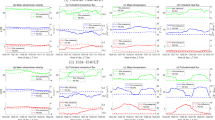Abstract
We calculated the wind-induced bending moments and stresses generated in the stems of five Prunus serotina conspecifics differing in height and canopy shape and size (based on detailed measurements of stem projected area and location with respect to ground level) to test the hypothesis that wind-loads generate uniform and constant stress levels along the lengths of tree twigs, branches, and trunks. These calculations were performed using five different wind speed profiles to evaluate the relative importance of the shape of wind speed profiles versus the ’geometry’ of tree shape on stem stress distributions and magnitudes. Additionally, we evaluated the effect of absolute tree size and stem taper on wind- induced stresses by scaling the size of smaller conspecifics to the absolute height of the largest of the five trees yet retaining the original stem proportions (i.e., diameter relative to stem length) for each plant. Finally, we also determined how the factor of safety for wind-loading (i.e., the quotient of stem yield stress and wind-load stress) changed as a function of tree size (and, presumably, age). Our results indicate that wind-load stress levels (1) vary along stem length even for the same wind speed profile and the same maximum wind speed; (2) would increase to dangerous levels with increasing tree height if it were not for ontogenetic changes in stem taper and canopy shape that reduce stress intensities to manageable levels; (3) tend to be more dependent on stem taper and canopy shape and size than on the shape of the wind speed profile; and (4) the factor of safety against wind-induced mechanical failure decreases as trees get larger, but varies along the length of large trees such that preferential stem failure is likely and functionally adaptive. We thus (1) reject the hypothesis of constant wind-induced stress levels; (2) support the view that size-dependent changes in stem taper are required to maintain wind-load mechanical reliability; and (3) suggest that certain portions of mature trees are ’designed’ to fail under high winds speeds, thereby reducing drag and the bending moments and stresses experienced by trunks.
Similar content being viewed by others
Author information
Authors and Affiliations
Additional information
Received: 24 May 1999 / Accepted: 8 October 1999
Rights and permissions
About this article
Cite this article
Niklas, K., Spatz, HC. Wind-induced stresses in cherry trees: evidence against the hypothesis of constant stress levels. Trees 14, 230–237 (2000). https://doi.org/10.1007/s004680050008
Issue Date:
DOI: https://doi.org/10.1007/s004680050008




